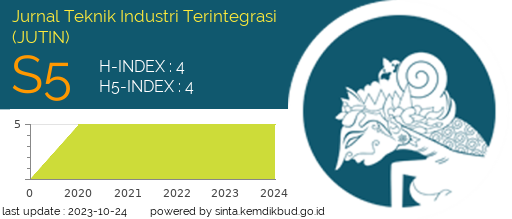Pengaruh Kecepatan Potong terhadap Kekasaran Permukaan Cetakan pada Mesin Milling CNC
DOI:
https://doi.org/10.31004/jutin.v6i1.16417Abstract
This study aims to determine the appropriate cutting speed in the milling process to produce good die surface roughness on 6061-T6 aluminum workpieces and to determine the effect of the cutting speed parameter of 30-50 mm/minute on surface roughness. Types of research methods and data collection will begin through a literature study process, by making working drawing designs then making chisel grooves and calculating VC and other parameters, followed by the milling process. Based on the results of the test data obtained, it shows that (1) Based on the graph obtained from the data table, the cutting speed (Vc) from the comparison of the base and wall between the core and cavity has where in this position the cutting speed (Vc) is 50 mm/min, which is the cutting speed (Vc) is the most optimal with engine speed (n) 1592.36 Rpm, Infeed speed (Vf) 636 mm/rev, and a constant Depth Of Cutting at 0.5. (2) The conclusion of this cutting speed (Vc) is that a high cutting speed will take faster machining time and have smoother surface roughness. (3) High cutting speed also does not justify any cutting speed. High speed must have a smooth surface roughness result. (4) Determine the characteristics of the material and then determine the right tool eye.Downloads
Published
2023-04-24
How to Cite
Thomas, F., Lubis , S. Y. ., & Rosehan , R. . (2023). Pengaruh Kecepatan Potong terhadap Kekasaran Permukaan Cetakan pada Mesin Milling CNC. Jurnal Teknik Industri Terintegrasi (JUTIN), 6(1), 304–312. https://doi.org/10.31004/jutin.v6i1.16417
Issue
Section
Articles of Research
License
Copyright (c) 2023 Felix Thomas, Sobron Yamin Lubis , Rosehan Rosehan

This work is licensed under a Creative Commons Attribution-ShareAlike 4.0 International License.






